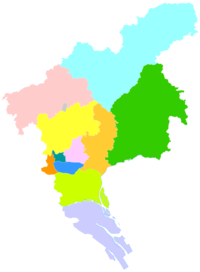Liwan District
|
Liwan 荔湾区 |
|
|---|---|
| District | |

Our Lady of Lourdes Chapel
|
|
 Liwan in Guangzhou
|
|
| Coordinates: 23°06′56″N 113°14′18″E / 23.11556°N 113.23833°ECoordinates: 23°06′56″N 113°14′18″E / 23.11556°N 113.23833°E | |
| Country | People's Republic of China |
| Province | Guangdong |
| Sub-provincial city | Guangzhou |
| Area | |
| • Total | 62.40 km2 (24.09 sq mi) |
| Population (2006) | |
| • Total | 705,262 |
| • Density | 11,000/km2 (29,000/sq mi) |
| Time zone | China Standard (UTC+8) |
| Postal code | 510145 |
| Area code(s) | 020 |
| Website | http://www.lw.gov.cn/ |
| Transcriptions | |
|---|---|
| Standard Mandarin | |
| Hanyu Pinyin | Lìwān Qū |
| Yue: Cantonese | |
| Yale Romanization | Laihwāan Kēui |
| Jyutping | lai6 waan1 keoi1 |
| Canton Romanization | lei6 wan1 kêu1 |
| Transcriptions | |
|---|---|
| Standard Mandarin | |
| Hanyu Pinyin | Lìwān |
| Yue: Cantonese | |
| Yale Romanization | Laihwāan |
| Jyutping | lai6 waan1 |
| Canton Romanization | lei6 wan1 |
| Transcriptions | |
|---|---|
| Standard Mandarin | |
| Hanyu Pinyin | Xiguān |
| Yue: Cantonese | |
| Yale Romanization | Sāigwāan |
| Jyutping | sai1 gwaan1 |
| Canton Romanization | sei1 guan1 |
| Transcriptions | |
|---|---|
| Standard Mandarin | |
| Hanyu Pinyin | Fāngcūn |
| Yue: Cantonese | |
| Yale Romanization | Fōngchyūn |
| Jyutping | fong1 cyun1 |
| Canton Romanization | fong1 qun1 |
Liwan District is one of the ten districts of Guangzhou, People's Republic of China. The district is split into two parts by the Pearl River: Xiguan in the northeast and Fangcun in the southwest.
Liwan District was named after "Lizhiwan", which is derived from poem of "a bay of green water and red lychees along both banks". It covers an area of 16.2 square kilometres (6.3 sq mi) and has a permanent population of about 540,000 and a permanent nonnative population of over 200,000. Liwan District is positioned in the flourishing west part of Guangzhou, on the northeast bank of the Pearl River.
Liwan was originally a western suburb of Guangzhou known as Xiguan and Huadai/Huadi located in between two counties of Panyu County and Nanhai County. On 15 February 1921 Liwan along with Guangfu (present Yuexiu) formed the City of Guangzhou.
Fangcun, in the western part of Liwan District, lay at the southwest of Guangzhou's downtown area and south of Pearl River. It was established as a "Fangcun District" in 1949 after the Chinese Communist Party took over Guangzhou from the Kuomintang. In 2005, it was withdrawn and merged with Liwan.
Liwan district has a well-developed transport network which enables it to reap benefits as an important place for business. There is a developed traffic network connecting with the railway station and Guangzhou Baiyun International Airport in the north. Renmin Bridge and Zhujiang Tunnel link the banks of the Pearl River in the southern part of Liwan. Zhujiang Bridge, which connects Nanhai and Foshan, links the east and west together in Liwan's west. Guangzhou South Railway Cargo Station of Jingguang Railway and Xinfeng Terminal are in Liwan's southwest. No. 107 State Highway and Guang-Fo Highway connecting with Guang-Shen Highway are through to Hong Kong. Line 1 of Guangzhou Metro and Inner overhead road pass through the District.
...
Wikipedia
